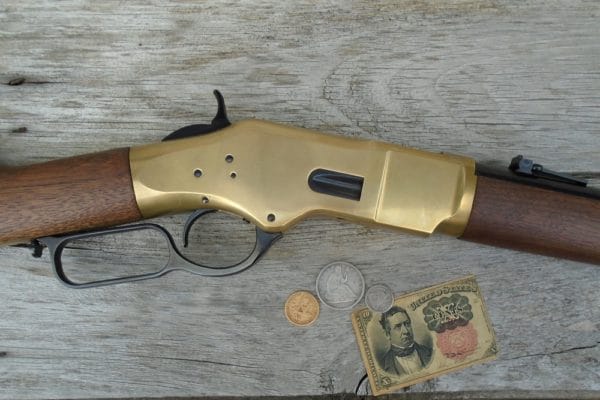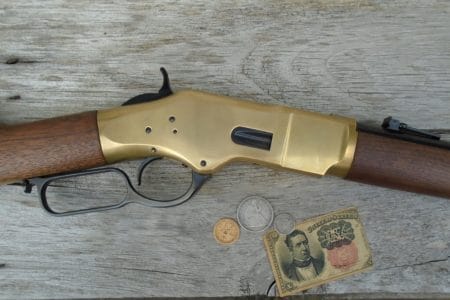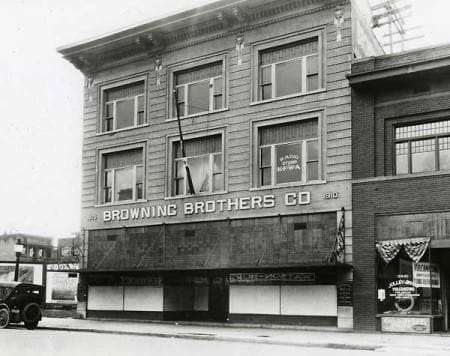
USA – -(Ammoland.com)- On June 8, 1898, Benjamin Tyler Henry passed away at the age of 77. If it hadn’t been for Henry and his repeating rifle design, Winchester and his rifle might not have become the iconic firearm that it is today.

Born in 1821, Benjamin Tyler Henry entered the arms trade the same way many young men of his day did: by an apprenticeship. He worked his way up and eventually became foreman at Robbins & Lawrence. It was there that he met Horace Smith and Daniel Baird Wesson.
Tangentially, Henry became acquainted with Oliver Winchester in 1854, who was an investor in the first Smith & Wesson venture. By 1857, Winchester had control of the Smith & Wesson Company, which became the Volcanic Repeating Arms Company, which became the New Haven Arms Company, of which Winchester named Henry the plant superintendent.
When Henry patented his new lever-action rifle in October 1860, he couldn’t have known the ripple effect that his gun would have. Though it took until July 1862 to get the .44-caliber repeating rifles produced and ready for sale, they were a hit with the men who got to try one out. Soldiers fighting our bloody Civil War saw the advantage of this repeater.
D. S. Curtiss, Major of the 1st Maine Cavalry, said the Henry rifle was “far superior in all respects” and that he “would by no means use any other [rifle] if it could possibly be procured.” Major Ludlow of the U.S. Corps of Engineers was equally enthusiastic. Speaking about the 1864 battle of Allatoona Pass, he said ,“[w]hat saved us that day was the fact that we had a number of Henry rifles,” adding that the rapid fire produced by the rifles was something that “no man could stand in front of.”

Military officials were of a different opinion. Not only were Henry rifles more expensive to purchase than their muzzleloading counterparts ($42 each compared to $20 for a Model 1861 muzzleloader), their rapid firepower caused some officials to fear that soldiers would waste ammo if they could fire it faster. A soldier was more likely to make a well-aimed shot if he could only fire the gun three times a minute, they reasoned.
Secretary of War Edwin M. Stanton, Secretary of the Navy Gideon Welles, and President Abraham Lincoln himself all owned Henry rifles, but even with those big names behind him, Benjamin wasn’t able to budge the top military brass. His rifle was never adopted as a standard-issue firearm. In fact, only 1,731 rifles were actually purchased by the United States. Even so, many units purchased them privately and used them with great effectiveness in the field. The 7th Illinois Infantry is known to have carried Henry rifles. They even posed for a group photo, complete with their flag and their Henry rifles.

Henry’s rifle was only in production for a brief period of time. Despite its ingenuity, the gun had some drawbacks. Chief among them was the loading mechanism, which had an external sleeve that rotated out at the muzzle to allow rounds to enter the magazine tube located directly under the barrel. The brass follower worked its way from the muzzle toward the receiver with each round fired, which meant that a poorly placed hand could prevent the gun from cycling. A lack of handguard – because of the follower – also meant that the shooter could burn their hand on the barrel when the gun was fired rapidly.
Henry grew displeased with the royalty agreement he had with Winchester and the New Haven Arms Company. He even went so far as to try and get the state government to award him the entire company as a form of back pay! In short order, Oliver Winchester put an end to that possibility by reorganizing the business and forming the now-iconic Winchester Repeating Arms Company.

By 1866, production on Henry’s rifle came to an end with only 14,000 having been produced. Henry’s employment with Winchester also came to an end at this time. The gun he created didn’t disappear entirely, though. A similar rifle featuring a handguard and loading gate designed by Nelson King entered the market that same year under a new name: Winchester’s Model 1866.
It would be Winchester’s Model 1866 that paved the way for the most iconic lever action rifles of all time.
Despite their disagreements, one thing is for sure: had it not been for Benjamin Tyler Henry, Winchester might not be the household name that it is today.
Winchester died on December 10, 1880, and Henry followed on June 8, 1898. The two men never reconciled their differences.
About Logan Metesh
Logan Metesh is a historian with a focus on firearms history and development. He runs High Caliber History LLC and has more than a decade of experience working for the Smithsonian Institution, the National Park Service, and the NRA Museums. His ability to present history and research in an engaging manner has made him a sought after consultant, writer, and museum professional. The ease with which he can recall obscure historical facts and figures makes him very good at Jeopardy!, but exceptionally bad at geometry.






Top of the line equipment for that day. Custer lost his last fight partially because there were a LOT of Indians who used repeating rifles. Some of the best mid range rapid fire guns.
Arm up, carry on.
Agree !!
@DB, the GCA precludes us from using the top of the line equipment for our day. We could get caught as short as Custer.
Thank you for these history refreshers!